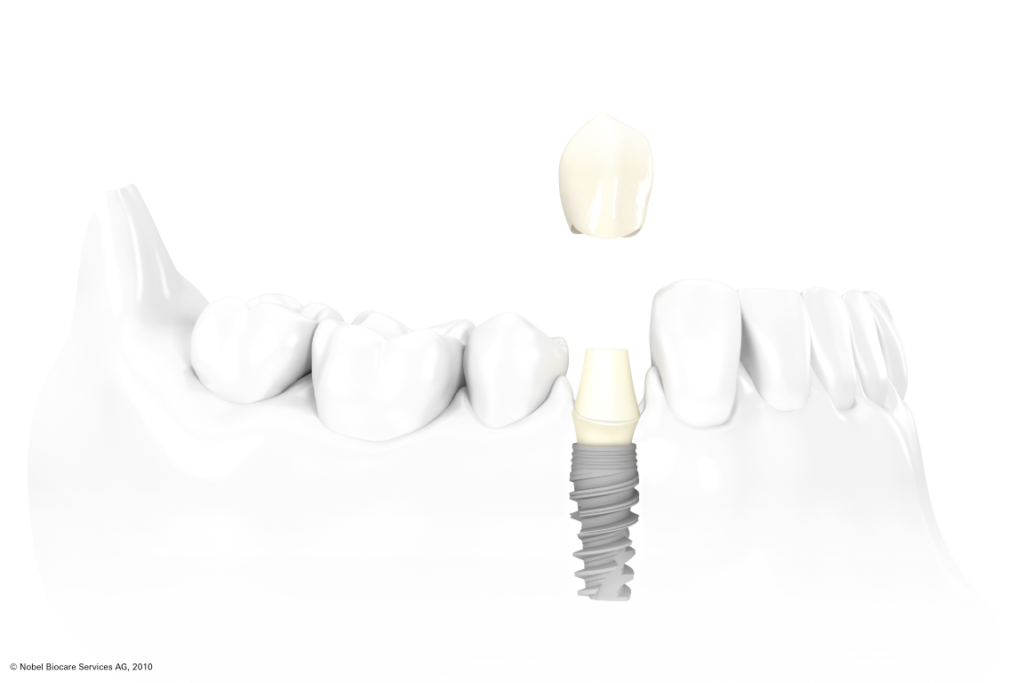In case a tooth is extensively damaged or crooked but other than that the root is good, there is no inflammation and therefore can be kept then the tooth is being covered by a dental root canal crown. A tooth crown protects the tooth and solves the functional and aesthetic problems. With crowns and bridges we can imitate the real teeth perfectly so that even experienced eyes might not see the difference between original and fake. Crowns and bridges are mainly made out of ceramic fused to metal or of full ceramic.
If natural teeth are used for a bridge then those are being prepared (grinded down) in order to be able to carry the dental bridge.
A crown can be fixed on an implant also if the tooth does not exist anymore or the damage is so extensive that it has to be removed and replaced. In this case we talk about an implant crown.
The type of tooth crown is very important, it is determined depending on the situation or the patient request. The most common types of crowns and bridges are the following:
FULLY CASTED CROWN although this type of crown is often used in therapy planning and theory, it is rarely used in practice. Evergreen Dental does not offer this type of crown at all. It is a metal crown of non-precious metal. This is the cheapest type of full crown, but because of the optical defects and the compromise in wearing comfort, if at all, then only used in the molar area.
Porcelain fused to metal crown: these crowns have a metal frame and a ceramic lining on the surface. With the ceramic the anatomical effect is being created. These crowns are inexpensive and still they allow a very good stability and aesthetics. Both function and look are very good therefore it is the most chosen crown type. Much is depending on the ceramic master in the dental lab applying the ceramic lining as he/she will determine the final look and if the work is being done thoroughly the result can be a full anatomic tooth looking exactly like a natural tooth. Also the material used is of high importance therefore always make sure the best material is used for your dental work.
e.Max full ceramic crown: this metal-free crown type is being pressed of a ceramic block therefore it’s often called pressed-ceramic crown. E.Max crowns are very resistant and look just like natural teeth, are usually used in front region where the aesthetics has a major role.
Zirconia crown: just like full ceramic crowns Zirconia crowns are also completely metal-free, are extremely resistant and can withstand even the strongest chewing power are therefore often used in back region for the replacement of molars where the pressure is the highest. Also Zirconia is perfect for strong, durable, high-aesthetic bridges. It is being produced with the so called CAD/CAM method (computer-aided-design / computer-aided-manufacture) meaning that the crowns and bridges are being planned digitally and individually and also the production is steered by a computer. The teeth are individually being routed out of a Zirconia block then anatomically lined with ceramic.
CROWN ON PIN: root canal-treated teeth can also serve as a support for dental crowns. However, in a root canal treatment, the tooth interior, the vital pulp, is removed, resulting in loss of mass. This mass is filled up with a pin. This pin serves to further stabilize the crown and is mostly made either of metal or metal with fibreglass, in some cases of composite or ceramic.
TEMPRARY CROWN: is made of plastic for a transitional period and is therefore often called plastic crown. We distinguish between short-term temporaries and long-term temporaries. Short-term temporary restorations are usually done by the dentist for a maximum of one week in the dental office to protect the tooth stump, while long-term temporary restorations are made for a slightly longer period of time, up to 6 months, and made in the dental laboratory.
Long-term temporary crowns are usually made in case the bite needs adjustment before the final restoration. Often, an additional metal reinforcement is also incorporated. Possible causes are:
- Bruxism (overbite)
- Crooked teeth
- Under bites
While the patient wears the long-term temporary crowns, he gets used to the future anatomical conditions, because the bite is adjusted accordingly. This correction time usually takes between 2 and 6 months.
